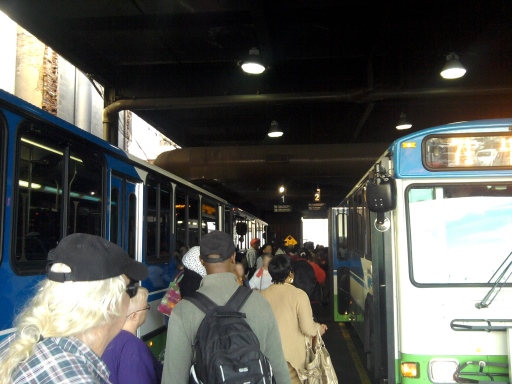 A well-traveled public transit system can resemble a networking session at a conference. Plenty of opportunities for networking and information exchange.
A well-traveled public transit system can resemble a networking session at a conference. Plenty of opportunities for networking and information exchange.
Economic development relies on economic efficiency, economic growth and process/technology development. Typically, none of these three are sufficient in isolation for economic development, but all three are necessary to some degree or another in combination. Let’s take a look at each one in turn:
- Economic Efficiency – The neoclassical model of economics presupposes, among other things, that all relevant information for market decisions and market opportunity is readily and freely available. In the complex world that we live in this is easier said than done. This is especially true if we are isolated and alone for our commutes. Carpooling, vanpooling and public transit offers the possibility to network and make connections. You can think of this as your own mini-conference or business meeting on the way to work.
- Economic Growth – Economies can often grow when business and economic activity between suppliers and customers increases within a given geography. In general the ability for a business to capture benefits when it locates among other businesses is called “Agglomeration Economies.” When the supply chain relationships between numerous businesses are concentrated and well defined we often call them “Clusters.” Public Transportation can serve such industrial clusters by opening up a wider labor market to the businesses involved. Sometimes those who are in the market for a prevailing wage, let’s say $10 per hour for argument sake, live in another part of the urban area from where such jobs are offered. For instance, these jobs may be in an economic development or industrial park and job candidates may not have reliable transportation to get between the two. When this happens we say that there is a “spatial mismatch.” Public transportation can help businesses grow by addressing this spatial mismatch and delivering the employees that a growing business needs. Please see the recent RCIT/Blue Hills Transportation Survey Analysis Report for more on these topics.
- Process and/or Technology Development – The economist Joseph Schumpeter articulated the concept of “Creative Destruction” by which new business processes and technologies displaced older less efficient processes and helped lead to economic development through entrepreneurialism. New process and technology ideas often come about through deep reflection on experience and/or by the cross-pollination of ideas by people in different businesses and industries. Often the process is a combination of both in mutually-supportive economic environments. Public transportation can provide the time to read, reflect and think that is important to this process. This is easy to observe in large urban areas such as the Washington DC metro area where many catch up on reading or work on the metro. Likewise, public transportation can provide the fertile ground for the cross-pollination of ideas through networking and conversation similar to that experienced at a conference. Finally, public transportation can be a place of creativity in general as is being demonstrated in the ongoing “Art by Bus” project.
Who knew that public transportation could accomplish so much for economic development? The benefits can accrue even if you only carpool, vanpool or take transit once a week. A longer list of employer benefits can be found here.

One Comment